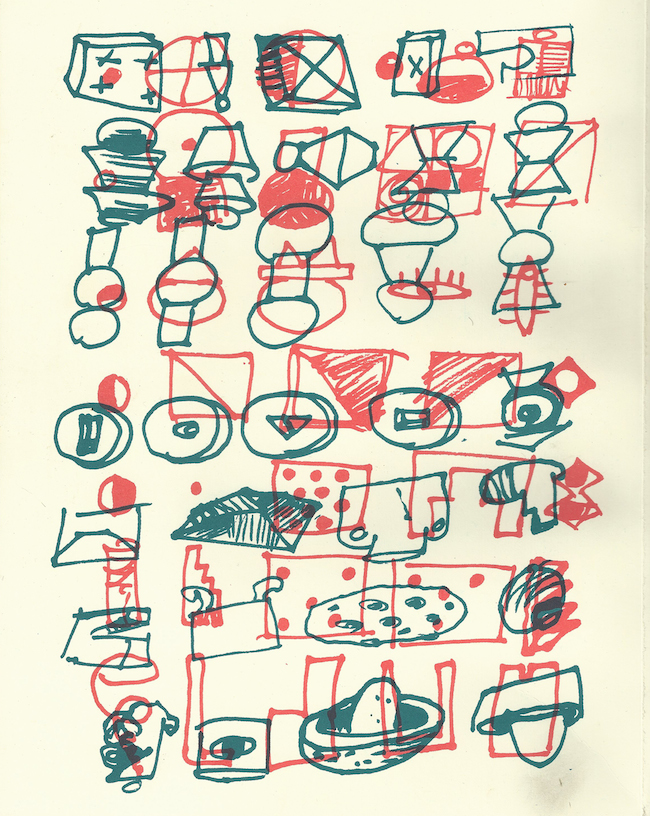Kirk Mangus: Things Love/
Introduction by Christine Havice, director School of Art, Kent State University
with essays by Rose Bouthillier, William Busta, Glen R. Brown and Eva Kwong
MOCA Cleveland, , 2014
Softcover exhibition catalog, 232 pages. 220 illustrations. 10 x 8 inches
When one, today, says, “I’m an artist” they usually mean, alongside my true passion of ceramics/painting/writing (etc.) I am a teacher at a university. We’re so used to this being a fact, or occupational synonym, that we don’t too often question the impact that teaching might have on an artist and I am thinking here of their time, their ability to produce in the face of a system that functions upon externalized (students) demands, eagerness and a necessity to ask and to know, which when one is a young artist can be inexhaustible.
Above image: Kirk Mangus “Things Love” exhibition catalog cover.
Against this demand you might think that the artist would have a fertile intellectual environment, but little time to produce work and especially to produce prolifically, but Kirk Mangus: Things Love presents a body of work which is enormous, spanning from ceramic works to drawings and paintings. It also include a brief selection of Magnus’ comically turned poetry. Mangus was a person who must have not only produced everyday, but more frequently many artworks a day.
Whether his work is ceramic or graphic there are always many shared qualities to connect his oeuvre. Never does Mangus present a straight line or straight-jacketed shape such as a square, rectangle or perfect circle; he constantly stays fluid and playful in his lines and edges and surfaces. Another quality, perhaps his most remarkable, is his continued dialog throughout his artworks with the immediacy of life; constant motifs are people, animals, eyes and plants. Mangus’ driving forces seem to be witnessing, learning and an attempt to understand not only his world, but the world as it is known by others; his students, fellow artists, family pets and friends as well as insects.

Kirk Mangus, Untitled, ca. early 1980s, carved porcelain with ash glaze
Insects arise again and again, they hatch from his ceramic work and pester the people in his drawings and paintings and are a perfect allegory for the artist himself as we tend to think of insects as perpetually moving and constantly seeing with their numerous eyes, not to mention as creatures who live life busily. Mangus was all of these things.
The catalog is copious, tastefully designed and full of information about Mangus and the aims of his work. It presents an artist who is well-read, well-spoken, humble and Olympian in his energies and networking.
The final section of the catalog, subtitled Ephemera is an intriguing collection of Mangus’ thoughts, letters of recommendation, letters of introduction and photographs spanning his entire life and it’s a nice addition the collection as it seems to strengthen the sense that Mangus was expansive.

Kirk Mangus, Tiger, 2008, stoneware and underglazes
Mangus and his wife even appeared on episode 1545 of Mr. Rogers, with his wife Eva Kwong, as if he wasn’t prolific enough. Eva shows Mr. Rogers how to make a coil pot and Kirk unloads a kiln and shares Eva and his works with Rogers to wind out of the scene.
There is something perfect about Mangus appearing on a show about neighbors and neighborhood; a list of Mangus’ colleagues, students and collaborators would be too long to include here, but it is vast and eclectic.
Mangus staunchly opposed the minimalist tendencies that predominated much of the artistic scene during his college years in the early seventies. What he rejected was a tendency to control and a desire for efficiency which the young Mangus must have found so cold and removed from the energies of life. He desired an art that, like the flames in a kiln, defied control and any consistent adherence to rules and any single artwork of his contains this defiance whether from his early or later years.
If Mangus’ work has a drawback it might be that since he started with everything he had nothing to expand into. Though interested in different ceramic forms and ways of firing, Mangus seems constantly to provide the same themes again and again: expansion, play and curiosity. He played against rules so he never produced work based on any new ones. Artists who set a vague, abstract, though guiding rule for themselves often bloom and progress as a result. Whether or not Mangus found his bridge to that far shore of greatness, we must all decide for ourselves.
Kirk Mangus: Things Love was published to accompany the exhibition Kirk Mangus: Things Love presented at MOCA Cleveland September 26, 2014–January 18, 2015. Please see our accompanying post about that exhibition.
Christopher J. Johnson is CFile’s Book Reviewer
Any thoughts about this post? Share yours in the comment box below.

Kirk Mangus, Guys’ Night Out Teapot, ca. mid 1980s, earthenware with colored slips and clear glaze

Kirk Mangus, Smoking Chaac and Girl Wearing Dog Mask, 2007, ink on mulberry paper

Kirk Mangus, It Was A Long Night, 2003, watercolor on paper

Mangus at Earth, Air, Fire, and Water in the mid-1970s and a sketch for a kiln building

An untitled sketch by Kirk Mangus.

Add your valued opinion to this post.